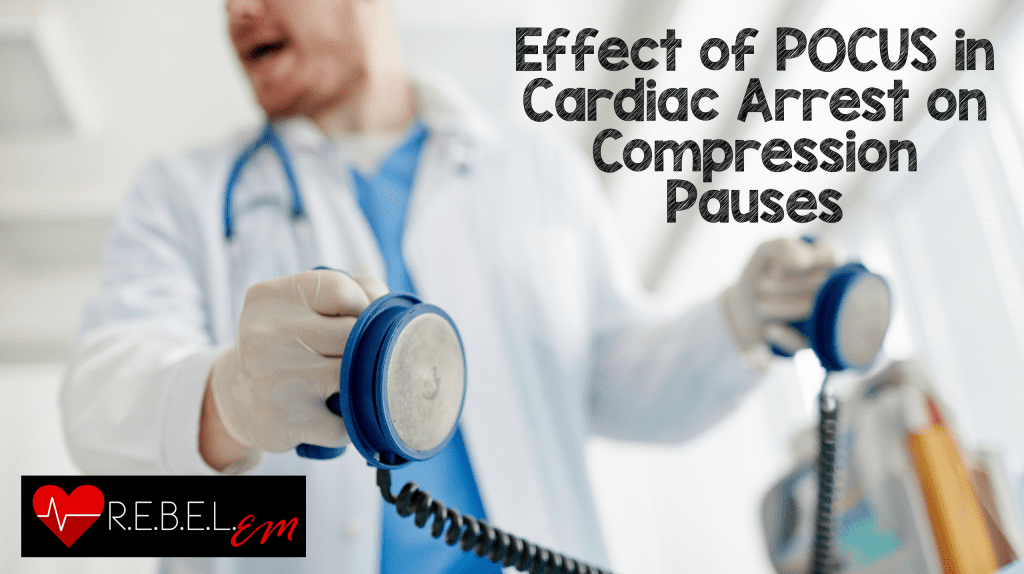
 Background: The provision of high-quality compressions with minimal interruptions is central to the management of cardiac arrest. Along with defibrillation, high-quality compressions are the only interventions proven to improve patient-oriented outcomes. Recently, point-of-care ultrasound (POCUS) has gained greater use in cardiac arrest care for determination the cause of arrest as well as guiding the resuscitation and interventions. Performance of POCUS during arrest can be challenging particularly in terms of obtaining cardiac windows. Among these challenges is obtaining images of the heart during compressions. As a result, cardiac POCUS is often performed during rhythm checks when there is a scheduled pause in compressions. Despite the potential benefit from POCUS in cardiac arrest, prolonged interruptions in compressions while attempting to get optimal windows is unlikely to benefit the patient and, may be harmful.
Background: The provision of high-quality compressions with minimal interruptions is central to the management of cardiac arrest. Along with defibrillation, high-quality compressions are the only interventions proven to improve patient-oriented outcomes. Recently, point-of-care ultrasound (POCUS) has gained greater use in cardiac arrest care for determination the cause of arrest as well as guiding the resuscitation and interventions. Performance of POCUS during arrest can be challenging particularly in terms of obtaining cardiac windows. Among these challenges is obtaining images of the heart during compressions. As a result, cardiac POCUS is often performed during rhythm checks when there is a scheduled pause in compressions. Despite the potential benefit from POCUS in cardiac arrest, prolonged interruptions in compressions while attempting to get optimal windows is unlikely to benefit the patient and, may be harmful.
Clinical Question: Does the use of POCUS during cardiac arrest care alter the duration of pauses in compressions?
Article:
Clattenburg EJ et al. Point-of-care ultrasound use in patients with cardiac arrest is associated with prolonged cardiopulmonary resuscitation pauses: a prospective cohort study. Resuscitation 2017. PMID: 29175356
Population: All patients presenting to a single, academic ED who either presented in cardiac arrest or experienced cardiac arrest in the ED.
Intervention: POCUS used during rhythm check
Control: POCUS not used during rhythm check
Primary Outcome: The differences in CPR pause duration with and without the use of POCUS in Cardiac Arrest
Design: Prospective cohort study
Excluded: Traumatic arrest, patients with ROSC prior to ED arrival, fewer than 2 CPR pauses or if the resuscitation was not videoed.
Primary Results:
- 24 cardiac arrest patients enrolled (out of a total of 82 arrest that were resuscitated in the time period)
- 110 CPR pauses with rhythm check in 86 of the pauses
Critical Results:
- Ultrasound used for any pulse check: 69% (59/86)
-
Duration of pulse check (primary outcome)
- Without POCUS: 14.2 seconds (95% CI: 11.1 – 17.4)
- With POCUS: 19.3 seconds (95% CI: 16.5 – 22.0)
- Diff: 5.0 seconds (95% CI: 0.9 – 9.1 p < 0.0001)
- When resus leader also performed POCUS, associated with 6.1 second longer CPR pause (95% CI 0.4 – 11.7)
- US fellowship trained attending associated with shorter CPR pause vs non-US fellowship trained: – 3.9 seconds (95% CI – 8.4 to 0.7)

Strengths:
- Prospective, cohort study with videotaped resuscitation removing recall bias and ensuring accurate times
- All video footage was reviewed by two data abstractors
- Performed analysis and recorded experience level of person performing US
- Adds to the scant literature on the topic of US impact on pauses during cardiac arrest care
Limitations
- Does not look at patient centered outcomes
- Small study and most of the cardiac arrests that occurred were not included due to absence of video
- Absence of explanation of pauses without rhythm check
- Single center study reduces external validity
Authors Conclusions: “In this prospective cohort trial of 24 patients with CA, POCUS during CPR pauses was associated with longer interruptions in CPR.”
Our Conclusions:
The use of intra-arrest POCUS was associated with an increased length of rhythm checks and, thus, an increased length in compression interruptions.
Potential to Impact Current Practice:
While this study is too small to show an effect on patient outcomes from prolonged interruptions, everything in the existing literature tells us that longer interruptions will lead to worse outcomes. Regardless of whether POCUS is used intra-arrest or not, interruptions in compressions should be minimized. Extending rhythm checks to obtain good US images is not acceptable.
The use of POCUS intra-arrest or of POCUS driven arrest care must be thoughtfully applied to reduce potentials for harm. Employing transesophogeal echo for assessment of compression quality, assessment of rhythm and reversible etiologies may be a superior approach as compression interruptions are unnecessary
Bottom Line:
Intra-arrest POCUS may increase the duration of rhythm checks which has the potential to worsen outcomes. Providers should be cautious to not allow POCUS to interfere with interventions proven to be beneficial (compressions and defibrillation). More research is required to investigate why interruptions are longer, potential benefits of POCUS in arrest and the impact of prolonged pauses in this situation.
References:
- Huis in’t Veld, MA et al. Ultrasound use during cardiopulmonary resuscitation associated with delays in chest compressions. Resuscitation 2017. PMID: 28754527
For More on This Topic Checkout:
- REBEL EM: Beyond ACLS: POCUS in Cardiac Arrest
- REBEL EM: The REASON Trial: POCUS in Cardiac Arrest
- Core EM: ED POCUS in OHCA – The REASON Study
- Core EM: Impact of US Guided Cardiac Arrest Resuscitation on Compression Pauses
Post Peer Reviewed By: Salim Rezaie (Twitter: @srrezaie)
The post Effect of POCUS in Cardiac Arrest on Compression Pauses appeared first on REBEL EM - Emergency Medicine Blog.
